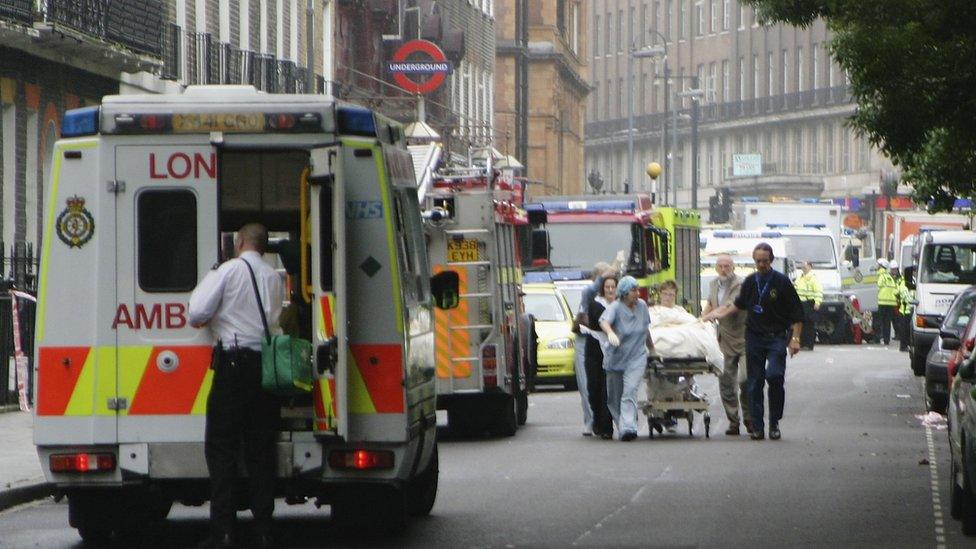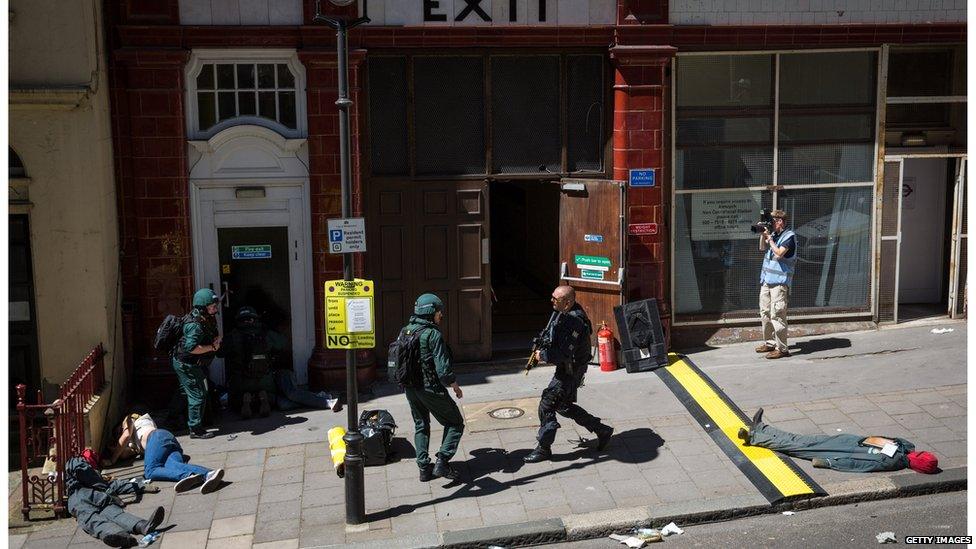7 July London bombings: 15 changes to anti-terror planning
- Published
The 7 July bombings on London were a wake-up call for those charged with preventing such attacks, and those expected to respond quickly in order to minimise injuries and loss of life.
Inquests into the deaths of the 52 people killed in the attacks resulted in several recommendations for security and rescue procedures, while the government has in place an ambitious counter-terrorism strategy.
So what has changed since that day?

Not just a nice sign - a terror deterrent too
1) Bollards. Since 7 July 2005 there have been substantial but often subtle changes to some cityscapes designed to make it harder for someone to launch a bomb attack. For instance, if you visit any of the UK's big cities you may pass bollards, low-level walls and even planters around buildings that have been designed to absorb the direct impact of a lorry carrying a bomb. One of England's largest sporting venues, the Arsenal Emirates Stadium, had features to withstand a terrorist attack built into it from the drawing board. Approaches to many train stations have been - or are being - redesigned to include what's known in the jargon as "hostile vehicle mitigation measures".
2) Regional MI5. The men who carried out the attack targeted London but came from outside the capital. In the wake of the bombings, MI5, the Security Service, increased its presence around the UK by setting up regional hubs, working with police to find out more about what was happening in communities outside London.
3) Intelligence sharing. Some of the 7/7 bombers had crossed the security services' radar before. While it was later decided the London attacks could not have been prevented, improved procedures would ensure intelligence - such as surveillance photos - were better shared among police and MI5. It was also agreed that more should be done to re-assess those who had come across the radar in the past and been judged a lower threat, to see if that had changed.
4) Digital data gathering. The realisation these were home-grown suicide bombers also led to a better focus on collecting digital intelligence, since targets were increasingly leaving an electronic trail, including one of their online behaviour. This led to the creation of new capabilities at GCHQ specifically to look for signs like communication or contact with places like Pakistan or the visiting of extremist websites. Overall, this was part of a wider push to have all three British intelligence agencies - MI5, MI6 and GCHQ - work much closer together.

Read more - 7 July attacks

5) Ambulance response. Medics were late to some of the attack scenes - including a 52-minute delay to Tavistock Square, scene of the bus attack. Training has since been improved and the service has introduced different protocols for major incidents. There is now a pre-determined response for anything that is characterised as one - the Apollo Theatre roof collapse in December 2013 was an example. Twenty ambulances are sent immediately along with other available emergency support vehicles. Extra supplies of bandages and tourniquets are also sent, while 10 specially-trained officers are dispatched to co-ordinate the response on the ground.
6) Tube stations numbered. One reason for the ambulance delays was the fact some were sent to the wrong location. There was a lack of co-ordination at some Tube stations. Each Tube station now has a specific "meeting point" for the emergency services to gather at, along with an individual code number and exact co-ordinates. From there, supervisors are meant to co-ordinate all of the emergency services. Also, every station and tunnel now has a unique number so the location of the incident can be identified - and everyone working on the response knows where it is.
7) Tube communications. If communications were flawed above ground, in the tunnels where the bombs were set off they were "inadequate" and "non-existent", according to one report. Now there are new radio systems for London Underground (LU) and the emergency services - different systems, but ones which talk to each other at command level. "These systems give every Tube staff member a personal radio and the ability to contact any other," says LU. "They also allow the broadcast of centralised messages from control rooms to any number of staff across the network." However, the Fire Brigades Union disputes that communications work flawlessly - saying the new radios work erratically.

Ambulance crews were delayed getting to some locations on the day
8) Police-like command structure. The Underground has also adopted the Gold, Silver and Bronze command structure used by emergency services in major incidents. Gold commanders in the control room oversee the entire response and set strategy. There is then a silver commander at each site who decides on the precise tactics needed. Bronze commanders manage individual teams carrying out specific tasks. Also, to increase co-ordination many of the major commands - radios, power, British Transport Police - are now in the same room. In 2005 they were in different buildings across London and did not have a coherent or consistent system for talking to each other.
9) Power down. Some emergency services were delayed getting onto the tracks on 7 July as they didn't know if the electric rails were still live. Now a designated staff member will go to an agreed meeting point to brief the emergency services when they arrive. Tube engineers used to get stuck in traffic. Now, they have police drivers so are able to use blue lights to get to incidents.
10) Staffing changes. As the Tube hits a record number of passengers, ticket offices are being closed in favour of automated machines. Tube bosses say this means more staff at ticket barriers, ready to help in emergencies. However, the RMT union fears safety will be hurt and it wants the changes frozen.
11) First aid kits. After 7/7 multi-casualty kits have been put in 170 locations around London. These major trauma kits are a key part of the emergency response: the police know where they are and the first responders to an incident would be told to pick them up because they could help save someone's limb.
12) Preparing for the worst. Police and security chiefs in Whitehall are now tasked with thinking through every "what if" scenario they can come up with so they have a tactic to confront a range of threats. Those tactics are regularly refined based on the general intelligence picture, and, as shown in a recent major exercise, key agencies train together. The immediate priority after 7 July was rethinking urban transport security. Recent atrocities in Paris, Sydney and Ottawa have underlined that the police need tactics to deal with attackers on the move.

Key agencies work together in a training exercise against a terrorist attack, last month
13) Relations with Muslims. One of the great unresolved questions for government is its complex and difficult relationship with Muslim communities and a whole series of groups that say they speak for them. Labour tried a series of approaches - reaching out through its traditional political base. A lot of those links were ditched with the 2010 change in government for two reasons:
officials had long suspected they may have been backing the wrong groups - throwing money at people who, with hindsight, didn't know the extremists or, worse, didn't want to admit the problem
secondly, incoming Conservative ministers took a far harder line, saying they would not deal with anyone who they felt had the whiff of intolerance about them
Today, Whitehall insiders who tailor the message to British Muslims and the wider Islamic world know they still face an uphill struggle to be heard. But at the same time, the sheer scale of the Syria crisis - and the undeniable fact that some entire families seem to believe in the self-styled Islamic State's utopian vision, has opened up a far more public debate among Britain's Muslim communities over how to counter extremism.
14) Border protection. The Home Office has dedicated millions of pounds to rethinking the way it receives and analyses data about people coming in and out of the country. Slowly but surely, border officers are able to collect more and more information about incoming passengers - and they have the power now to order airlines to remove someone from a plane before it leaves for the UK.
15) Dealing with the aftermath. Beyond the emergency services, government officials have been training for their role in helping families cope with the aftermath. The recent attack on a beach in Tunisia has been the first major test of those responses. The coming inquests will reveal whether the bereaved families got all the support they needed.
Contributors: Dominic Casciani, BBC home affairs correspondent; Gordon Corera, BBC security correspondent; Tom Edwards, BBC transport correspondent, London; Nick Triggle, BBC health correspondent.